To raise kids who love the ride, start by choosing bikes that fit their size and skill level, and equip them with safety gear like helmets and pads. Make rides fun by exploring new routes, playing games, and letting your kids pick destinations. Teach safety rules and bike maintenance to build confidence and responsibility. Encouraging independence and sharing enjoyable family outings will foster lifelong cycling enthusiasm—keep going to discover how to turn these strategies into lasting bonding moments.
Key Takeaways
- Choose appropriately sized bikes and safety gear to make riding comfortable, secure, and enjoyable for kids.
- Incorporate fun activities, games, and scenic routes to boost kids’ enthusiasm and curiosity about cycling.
- Teach traffic safety rules, proper signaling, and responsible riding habits to build confidence and independence.
- Start with easy rides, celebrate successes, and involve kids in decision-making to foster self-esteem and ownership.
- Share family cycling adventures and teach bike maintenance to develop lifelong love and appreciation for riding.
Choosing the Right Bike and Gear for Your Kids
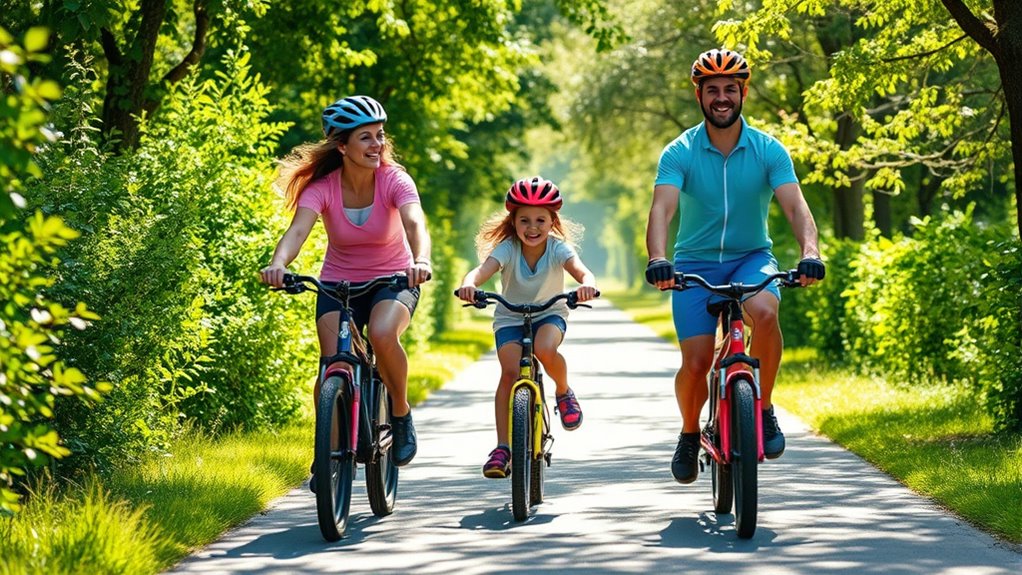
Choosing the right bike and gear for your kids is essential to guarantee their safety, comfort, and enjoyment. Start by selecting a bike that fits their size and skill level; a proper fit reduces the risk of injury and makes riding easier. Consider bikes designed for different cycling destinations, whether for casual neighborhood rides or rougher trails. Regular bike maintenance keeps the bike in top condition, ensuring safety and smooth performance. Invest in safety gear like helmets, knee pads, and reflective clothing to protect your child and enhance visibility. The right gear and a well-maintained bike boost confidence, making every ride more enjoyable. Additionally, choosing a bike suitable for local environments, such as Water Parks with nearby attractions, can make outings more fun and convenient. When you choose wisely, your kids will develop a love for cycling and explore new destinations with ease. Understanding bike safety and proper gear use can further ensure your child’s enjoyment and protection on every ride. To enhance their experience, consider adding headphones for audio entertainment during long rides, but always ensure they do not distract from safety awareness. Proper gear fitting also helps prevent discomfort and encourages longer, more enjoyable rides.
Making Rides Fun and Engaging for Young Cyclists
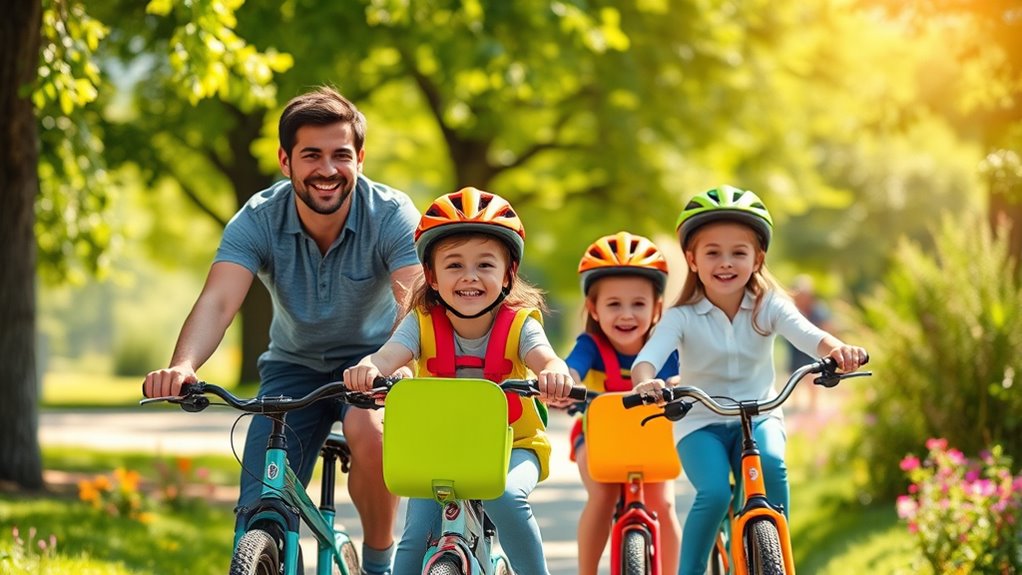
To keep young cyclists excited about riding, it’s important to make every outing fun and engaging. You can introduce simple bike tricks like wheelies or balancing exercises to add a playful challenge. Mixing up cycling routes keeps rides fresh and interesting—try exploring parks, trails, or scenic neighborhoods. Incorporate games like “I spy” or relay races to boost their enthusiasm. Let your kids choose some destinations or stops along the way to give them a sense of ownership. Using colorful accessories or fun helmets can also make riding feel special. Additionally, sharing stories about historical farmhouses and their unique architectural features can inspire curiosity about local heritage. Understanding survival skills such as basic first aid or navigation can be a fun way to teach safety while riding. Practicing self-exams regularly can help children become more aware of their bodies and health, fostering early awareness of health issues. Ensuring the bike and scooter equipment are properly maintained can make rides safer and more enjoyable for kids. Incorporating mindfulness practices into rides can help kids stay present and enjoy the experience more fully. The goal is to create positive, memorable experiences that inspire your kids to look forward to each ride, turning cycling from a chore into an adventure they love.
Teaching Safety and Responsible Cycling
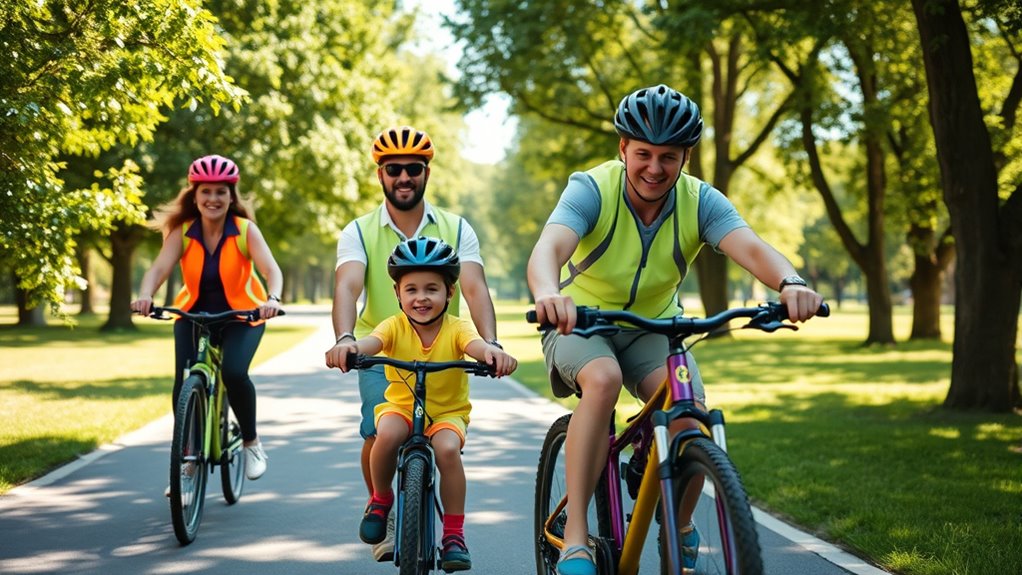
Ensuring young cyclists understand safety rules is essential for their protection and confidence on the road. Start by emphasizing helmet safety; always wear a properly fitted helmet to protect against head injuries. Teach them how to check for a secure fit and explain why helmets are vital. Next, focus on traffic rules—stop at stop signs, signal turns, and look both ways before crossing intersections. Make sure they understand that following traffic laws keeps everyone safe, including pedestrians and drivers. Practice these rules regularly during rides to reinforce good habits. Encourage your kids to stay alert, avoid distractions, and respect other road users. By instilling these safe and responsible cycling habits early, you’re helping them develop lifelong skills that keep them safe and confident on every ride. Learning about anime movies and animated stories can also inspire creativity and cultural appreciation during their leisure time. Additionally, teaching them about bike maintenance and basic repairs can empower them to handle minor issues independently, fostering responsibility and confidence. Recognizing the importance of AI security measures can help parents and educators understand the value of safety protocols in technology, which can be translated into teaching children about digital safety. Incorporating somatic therapy techniques can also help children manage anxiety and build resilience in stressful situations. Regularly monitoring indoor air quality with an air purifier can create a healthier environment that supports their overall well-being.
Building Confidence and Independence on the Bike
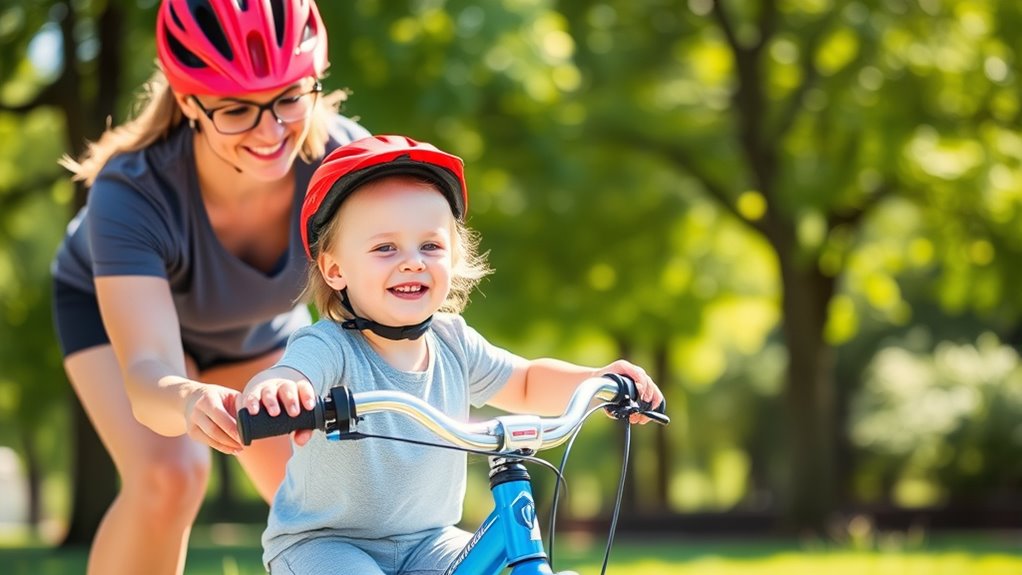
Building confidence and independence on the bike comes from gradual exposure and positive reinforcement. Start with short, easy rides to help your child become comfortable pedaling and steering. Teach them basic bike maintenance, like checking tire pressure and adjusting brakes, so they feel more in control. As they improve, encourage them to practice cycling etiquette, such as signaling turns and sharing the road respectfully. Praise their efforts and celebrate small successes to boost their self-esteem. Let them make decisions during rides, like choosing routes or stopping points, to foster independence. Regular practice sessions help reinforce skills and build familiarity with riding. Consistent practice and supportive feedback help your child trust their skills and enjoy riding on their own. Over time, they’ll develop the confidence to explore new paths and ride with less supervision.
Inspiring a Lifelong Love for Pedal Power
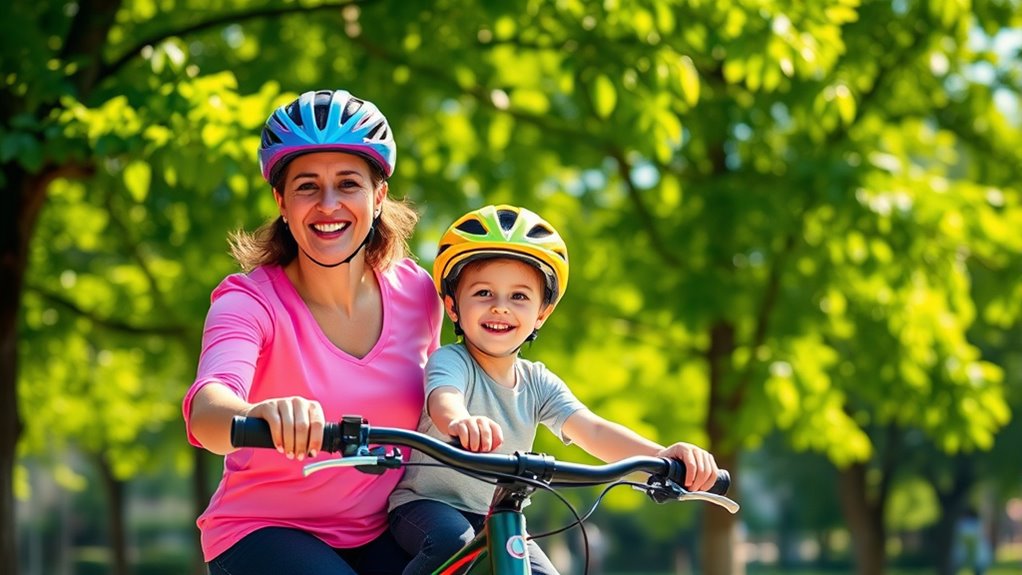
Encouraging your child to enjoy cycling beyond just gaining confidence helps foster a lifelong love for pedal power. Take them on exciting cycling adventures that spark curiosity and joy, whether through scenic trail rides or exploring local parks. When they see cycling as fun and rewarding, their enthusiasm grows naturally. Teaching basic bike maintenance also plays a key role; showing them how to fix a flat or adjust brakes boosts their independence and pride in riding. Make bike care a regular part of your outings, so it becomes second nature. Additionally, introducing them to cycling safety guidelines helps build their trust and understanding of safe riding practices. Incorporating hybrid bikes into your family rides can provide a versatile and comfortable option suitable for various terrains and skill levels. Understanding family cycling dynamics can further enhance your shared experiences and strengthen bonds. As your child develops a positive connection with cycling, they’ll be more motivated to explore new routes and embrace cycling as a lifelong activity, turning pedal power into a true passion.
Frequently Asked Questions
How Can I Encourage Hesitant Children to Try Biking?
To encourage hesitant children to try biking, use motivational strategies like praising small successes and setting achievable goals. Make safety precautions a priority by demonstrating proper gear use and practicing in safe environments. Let your child pick their bike or accessories to boost excitement. Stay patient and positive, offering encouragement along the way. This approach builds confidence and makes biking an enjoyable experience, helping them develop a lifelong love for riding.
What Are Signs My Child Is Ready for a Bigger Bike?
Your child’s readiness for a bigger bike is a game-changer! Look for signs like steady riding, good control, and comfort with their current bike size. When they can confidently start, stop, and handle turns, it’s time for an upgrade. Their riding confidence should be high, and they shouldn’t struggle to reach pedals or handlebars. If they’re enthusiastic and balanced, a bigger bike will boost their adventure even more!
How Do I Handle Disagreements Over Bike Route Choices?
When disagreements over bike route choices arise, you should focus on route compromise and safety negotiation. Talk with your child openly, listen to their preferences, and explain safety concerns. Together, find a route that balances fun and safety, like choosing a less busy street or bike path. This approach encourages cooperation, builds trust, and helps your child learn to prioritize safety while respecting their preferences.
What Should I Do if My Child Experiences Bike-Related Injuries?
Imagine your child falls during a bike ride, and you’re worried about their safety. First, stay calm and check for injuries, prioritizing injury prevention. If they’re hurt, seek immediate medical attention if needed. Use this experience to reinforce bike safety rules, like wearing helmets and checking equipment. Supporting your child through injuries helps teach resilience and emphasizes the importance of safety, ensuring they enjoy biking while staying protected.
How Can I Involve My Child in Bike Maintenance and Repairs?
To involve your child in bike maintenance and repairs, start with bike safety and maintenance basics. Show them how to check tire pressure, inspect brakes, and clean the chain. Invite them to help with simple tasks like tightening bolts or applying lubricant. Make it fun and educational, encouraging their curiosity. This hands-on approach builds confidence, teaches responsibility, and deepens their understanding of bike care, fostering a lifelong love of riding.
Conclusion
As you guide your kids on two wheels, remember that every confident pedal stroke is a step toward independence. While the thrill of their first ride sparks joy, patience during falls and struggles builds resilience. Balancing fun with safety, you shape not just skilled cyclists but also lifelong adventurers. Ultimately, it’s the mix of challenge and cheer that turns everyday rides into cherished memories—fueling a passion for pedaling that lasts a lifetime.








